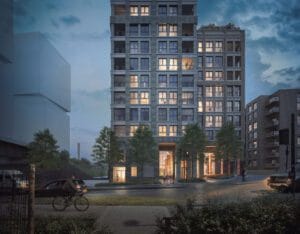Pioneering scheme combines residential and industrial uses
A resolution to grant planning permission has been received for the demolition of an existing Jewson hardware store for a mixed-use, 25-storey residential tower at Ilderton Wharf, Southwark. The new development comprises three towers of nine, 23 and 25 storeys and will deliver 170 apartments, including 61 affordable homes and a replacement builders’ merchant on the ground floor.
Motion supported Twenty Twenty Ilderton Wharf Limited and SGBD Property Holdings with transport planning, sustainable and active travel, access, delivery and servicing advice,

Complexities of use handled
David Hill, Director at 2020 Capital, comments, “IIderton Wharf is a pioneering scheme demonstrating how residential and industrial uses can coexist, which is very rarely achieved in London. Motion successfully handled the complexities of retaining the use for the builders’ merchant site and providing for 170 residential units above.” David adds, “Due to the development being located on the boundary of Southwark and Lewisham, the team worked effectively with both local authorities and the involvement of the GLA. They also dealt with the commercial and residential access requirements.”
Green amenities
The mixed tenure homes will have access to a wealth of open space, from oversized balconies providing ‘outdoor rooms’ and winter gardens, to south-facing communal gardens offering play and amenity space for children and teenagers onsite. The scheme will provide new improved public realm at ground level including the addition of sensitive lighting, bird and bat boxes and insect hotels.


Motion Technical Director, Chris Saunders, says, “A travel plan has been developed to provide a long-term strategy for encouraging residents, employees and visitors to choose more sustainable modes of travel.” Chris adds, “Improvements to bus services, provision of New Bermondsey overground station and the potential extension of the Bakerloo Line along the Old Kent Road will significantly improve accessibility to the site.”
Image credit: © Stitch Architects
An abridged version of this article first appeared in the Sustainability Special Issue of Insight


